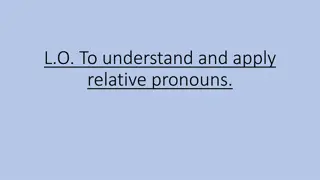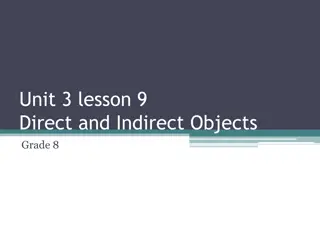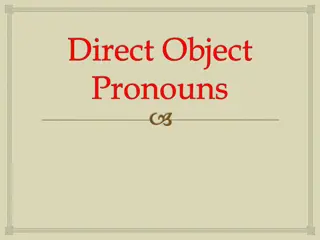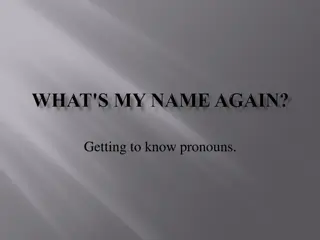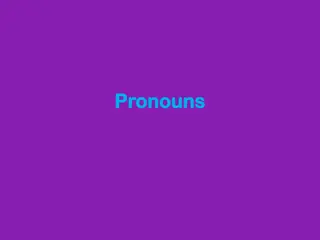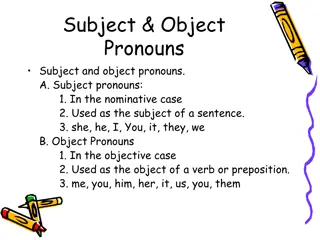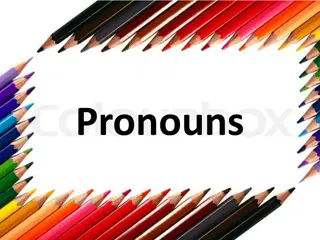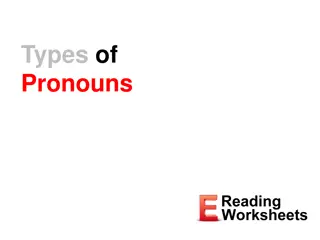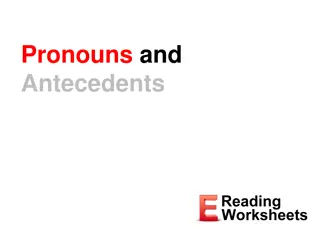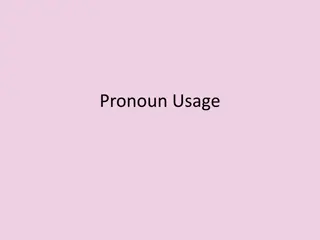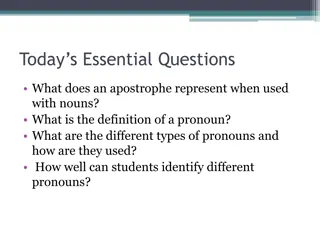Understanding Direct Objects and Direct Object Pronouns
Direct objects receive the direct action of the verb, and when they are people or domesticated animals, the personal "a" is used. Direct object pronouns replace the object to avoid repetition. Learn more about the personal "a", its usage, and how to identify direct objects in sentences.
Uploaded on Sep 15, 2024 | 0 Views
Download Presentation

Please find below an Image/Link to download the presentation.
The content on the website is provided AS IS for your information and personal use only. It may not be sold, licensed, or shared on other websites without obtaining consent from the author. Download presentation by click this link. If you encounter any issues during the download, it is possible that the publisher has removed the file from their server.
E N D
Presentation Transcript
Direct Objects, the Personal a, and Direct Object Pronouns (Los complementos directos, la a personal, y los pronombres de complemento directo)
A direct object is a thing or person that receives the direct action of the verb. I eat the tamales. Yo como los tamales. scar kisses his wife. scar besa a su esposa.
Notice that direct objects that are people or domesticated animals (and sometimes personified things) are signaled by the personal a. scar kisses his wife. scar besa a su esposa. I walk my dog every morning. Paseo a mi perro todas las ma anas. Patriots love their country. Los patriotas aman a su patria. More information about the personal a follows on the next slide.
More on the personal a Generally, the personal a is not used after the verb tener. scar tiene una esposa muy bonita. scar has a very pretty wife. Nor is it used with a direct object that is an unspecified or indefinite person. Buscamos una secretaria eficiente. We re looking for an efficient secretary.
More on the personal a The personal a followed by the definite article el contracts to form al. Alicia visita al m dico. Alicia visits the doctor. When the interrogative qui n(es) requests information about the direct object, the personal a precedes it. A qui n llama Elisa? Whom is Elisa calling? The personal a must be repeated before each human direct object in a series. Visito a Emilio y a Lola. I visit Emilio and Lola.
Identifying a direct object A direct object is a thing or person that answers what or whom, respectively, in the following equation: SUBJECT + VERB + WHAT (WHOM) DIRECT OBJECT Yo como los tamales
Pronouns are particles (little words) that take the place of the object itself, so that the object does not have to be repeated ad nauseum . . . Did you buythe piano? Yes, I boughtthe piano. Did you pay a lot forthe piano? Well, the pianowasn t cheap. Can you playthe piano? Yes, and my brother playsthe pianotoo.
Pronouns are particles (little words) that take the place of the object itself, so that the object does not have to be repeated ad nauseum . . . the piano the piano the piano the piano the piano the piano Notice how many times the piano was repeated.
Pronouns are particles (little words) that take the place of the object itself, so that the object does not have to be repeated ad nauseum . . . A better, more concise way is to use pronouns instead of repeating the noun over and over. Did you buythe piano? Yes, I boughtit. Did you pay a lot for Well, wasn t cheap. Can you play Yes, and my brother plays ? it it ? it too. it
Direct object pronouns in Spanish, just as in English, take the place of the direct object itself, so that the direct object does not have to be repeated, and repeated, and repeated . . . Comprasteel piano? S ,locompr . Puedes tocar S , y mi hermano lo ? lo sabe tocar tambi n.
The direct object pronouns in Spanish are as follows: These are used exclusively me te nos os for people These are used lo, la (lo, la) (los, las) los, las for people and things
Now lets see how pronouns replace things or people that are direct objects. I eat the tamales. Yo como los tamales. Yo los como. Notice that third-person direct object pronouns agree in gender and number with the noun they replace.
Now lets see how pronouns replace things or people that are direct objects. scar kisses his wife. scar besa a su esposa. scar la besa. Notice that third-person direct object pronouns agree in gender and number with the noun they replace.
Notice that the personal a goes away when the direct object noun is replaced by a direct object pronoun. scar besa a su esposa. a scar la besa.
PLACEMENT OF PRONOUNS ALL object pronouns are placed either before a conjugated verb (except for affirmative command forms) scar la besa. ( scar, b sala.) or after an infinitive or gerund (present participle). scar la va a besar. scar va a besarla. scar la est besando. scar est bes ndola.
Direct object pronouns are commonly used in conversation when the object is established or known. Again, this avoids needless repetition. D nde ves a Jorge y a Sarita? Where do you see Jorge and Sarita? I see them in class. Los veo en clase. Visitas a tu abuela con frecuencia? Do you visit your grandmother often? S , la visito mucho. Yes, I visit her a lot. Do not be misled into thinking that los and la in the above answers are the subjects of the sentences just because they appear in subject position. The subject of both answers, which is of course yo, is simply not expressed in these instances.
Be aware that object pronouns, just like verbs, must make a flip-flop transition when first and second persons are involved in the conversation. Me vas a invitar a tu fiesta? S , te voy a invitar. Nos puedes ayudar ma ana? No, no los puedo ayudar.
In negative sentences, the direct object pronoun is placed between no and the conjugated verb. Adolfo no la va a llamar. Adolfo is not going to call her. But, again, as in affirmative sentences, the object pronoun may be attached to the end of the infinitive or present participle. Adolfo no va a llamarla.
El Pretrito de los verbos 19
El Pretrito: is a past tense ( -ed ) talks about what happened is a completed action I went to the store. I bought a shirt. I paid in cash. 20
The stem for regular verbs in the pret rito is the infinitive stem. Tomar tom- Hablar habl- Comer com- Beber Abrir Salir beb- abr- sal- 21
Pretrito endings for -ar verbs are: - -aste - -amos -asteis -aron 22
Pretrito endings for er / -ir verbs are: - -iste -i -imos -isteis -ieron 23
REMEMBER: accents on the yo form and the l / ella / Ud. form -ar / -ir nosotros form is the same in present and pret rito 24
Por ejemplo: (-ar verbs) tom tomaste tom tomamos tomasteis tomaron tomar 25
Por ejemplo: (-ar verbs) habl hablaste habl hablamos hablasteis hablaron hablar 26
Por ejemplo: (-er / -ir verbs) com comiste comi comimos comisteis comieron comer 27
Por ejemplo: (-ar verbs) trabaj trabajaste trabaj trabajamos trabajasteis trabajaron trabajar 28
Por ejemplo: (-er / -ir verbs) volv volviste volvi volvimos volvisteis volvieron volver 29
Por ejemplo: (-er / -ir verbs) abr abriste abri abrimos abristeis abrieron abrir 30
Por ejemplo: (-er / -ir verbs) escrib escribiste escribi escribimos escribisteis escribieron escribir 31
Unos Irregulares: Verbs ending in -car, -gar, and -zar have a spelling change in the yo form of the pret rito. buscar tocar practicar pagar jugar llegar almorzar empezar comenzar 32
The yo form of the pretrito changes to conserve the sound of the infinitive: -car -gar -zar -qu -gu -c toc jug rez 33
Por ejemplo: (-car verbs) busqu buscaste busc buscamos buscasteis buscaron buscar 34
Por ejemplo: (-car verbs) practiqu practicaste practic practicamos practicasteis practicaron practicar 35
Por ejemplo: (-gar verbs) pagu pagaste pag pagamos pagasteis pagaron pagar 36
Por ejemplo: (-gar verbs) jugu jugaste jug jugamos jugasteis jugaron jugar 37
Por ejemplo: (-zar verbs) almorc almorzaste almorz almorzamos almorzasteis almorzaron almorzar 38
Por ejemplo: (-zar verbs) empec empezaste empez empezamos empezasteis empezaron empezar 39
There are several Spanish adjectives that have a shortened form when they precede certain nouns.
The most common shortened adjectives are those that drop the final -o in front of a masculine singular noun. normal alguno bueno buen malo mal ninguno postrero primero tercero Note that alg n and ning n require the addition of an accent in order to maintain the proper word stress. shortened alg n some meaning good ning n postrer primer tercer bad third uno un one, a no, none last, final first
The adjective Santo is shortened to San when it precedes most masculine saints' names. San Diego San Jos San Juan San Lu s San Miguel San Tob as exceptions: Santo Domingo, Santo Tom s, Santo Toribio
There are two adjectives which are shortened before a noun of either gender: grande cualquiera cualquier any gran big
Ciento is shortened to cien when it precedes a plural noun of either gender or when it multiplies a number. ciento veinte 120 cien euros 100 euros cien mil 100,000
Los Nmeros en Espaol Spanish4Teachers.org Spanish Spanish4 4Teachers.org Teachers.org
Del 0 al 100 0-19 20 30 40 50 60 70 80 90 100 = = = = = = = = = veinte treinta cuarenta cincuenta sesenta setenta ochenta noventa cien Spanish4Teachers.org Spanish Spanish4 4Teachers.org Teachers.org
Del 20 al 99 Trick Ejemplo 21-29 veinti + n mero veintidos 31-39 treinta y + n mero treinta y tres 41-49 cuarenta y + n mero cuarenta y seis 91-99 noventa y + n mero noventa y nueve Notice: the numbers that only form one word are Spanish4Teachers.org Spanish Spanish4 4Teachers.org Teachers.org
Recuerda!!! Los n meros del 0 al 99 are very important because they make part of all the other numbers that follow Spanish4Teachers.org Spanish Spanish4 4Teachers.org Teachers.org
100, 200, 300, 400, , 900 To learn the numbers from 100- 999, we must first learn the ones ending in two CEROS. Like which ones??? Spanish4Teachers.org Spanish Spanish4 4Teachers.org Teachers.org
200, 300, 400, , 900 200 = doscientos 300 = trescientos 400 = cuatrocientos 500 = quinientos 600 = seiscientos 700 = setecientos 800 = ochocientos 900 = novecientos Trick: Number + cientos Be careful with these because they are exceptions!!! Spanish4Teachers.org Spanish Spanish4 4Teachers.org Teachers.org



